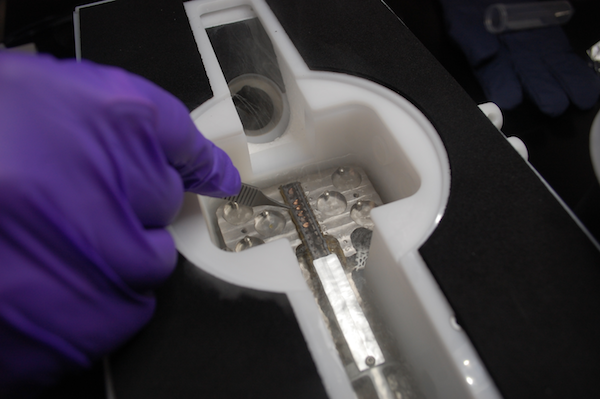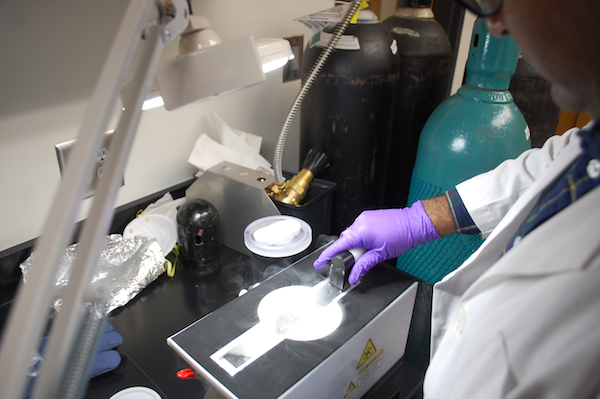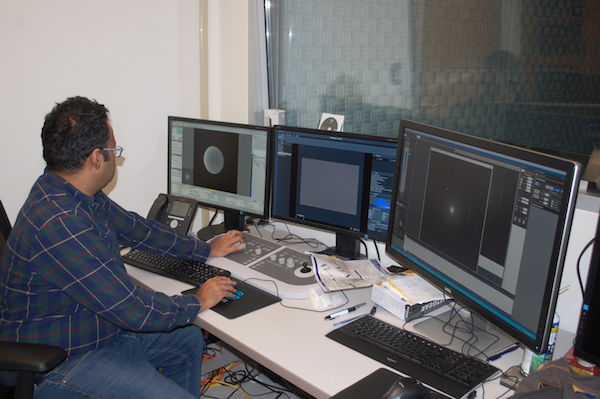In the last decade, a revolution has been taking place in structural biology, the field in which scientists produce detailed maps of how enzymes and other machines in the cell work. That revolution is being driven by cryo-electron microscopy (cryo-EM for short), which is superseding X-ray crystallography as the main data-production technique and earned a chemistry Nobel in 2017.
Just before COVID-19 sent some Emory researchers home and drove others to pivot their work toward coronavirus, Lab Land had a chance to tour the cryo-EM facility and take photos, with the help of Puneet Juneja, director of the core. Juneja demonstrated how samples are prepared for data collection — see the series of photos below.
Someone coming into the facility in the Biochemistry Connector area will notice a sign telling visitors and those passing by to stay quiet (forgot to take a photo of that!). The facility has electrical shielding and temperature/humidity controls. Also two levels of cooling are required for samples, since they are flash-frozen or “vitrified” in liquid ethane, which is in turn cooled by liquid nitrogen. The cooling needs to happen quickly so that ice crystals do not form. The massive cryo-EM equipment rests on a vibration-reduction platform; no music and no loud conversation are allowed during data collection.
One of the first structures obtained in this relatively new facility was the structure of a viral RNA polymerase, the engine behind viral replication. It wasn’t a coronavirus enzyme – it was from RSV (respiratory syncytial virus).
Still, cryo-EM is a way to visualize exactly how drugs that inhibit the SARS-CoV-2 polymerase – such as remdesivir or Emory’s own EIDD-2801 – exert their effects. Chinese researchers recently published a cryo-EM structure of the SARS-CoV-2 polymerase with remdesivir in Science.
Here at Emory, structural biologist Bo Liang was recruited in 2016 with the mission of establishing the cryo-EM facility. He led the project on the RSV polymerase structure, which was published in Nature Communications. Liang trained with Steve Harrison at Harvard, and was involved in producing another viral polymerase structure, one of the first with cryo-EM. He is intrigued by the elegance of viral enzymes.
“Viruses do so much with just one enzyme,” he says. “Our cells take more than 100 proteins to do the same thing.”
The utility and power of cryo-EM extends far beyond viral polymerases, though. For example, Emory biochemist Christine Dunham’s lab uses it to study ribosomes, the multi-component machines that synthesize proteins. Her colleague Graeme Conn and his lab examine resistance mechanisms for antibiotics that target ribosomes.
The previous workhorse approach, X-ray crystallography, requires scientists to be able to produce crystals of the protein or macromolecular assembly they are studying. Finding the right crystallization conditions for a given protein – the right concentration of the right kind of salt — was and is a bit of an art form. For many important proteins, it’s difficult because the protein has flexible joints or sits within a lipid membrane. Basically, the more complicated the miniature machine, the harder it is to crystallize.
Cryo-EM sidesteps the challenge of crystallization, but previously had a drawback of lower resolution, but the development of “direct electron detection” made the current high-resolution data production possible

1. Pouring liquid nitrogen


2, 3. EM grids before plunging into super cold liquid

4. Several EM grids

5, 6. Preparing samples on grids.


7. Loading sample into EM apparatus

8. Data collection occurs inside vibration-dampened room; scientists monitor outside

